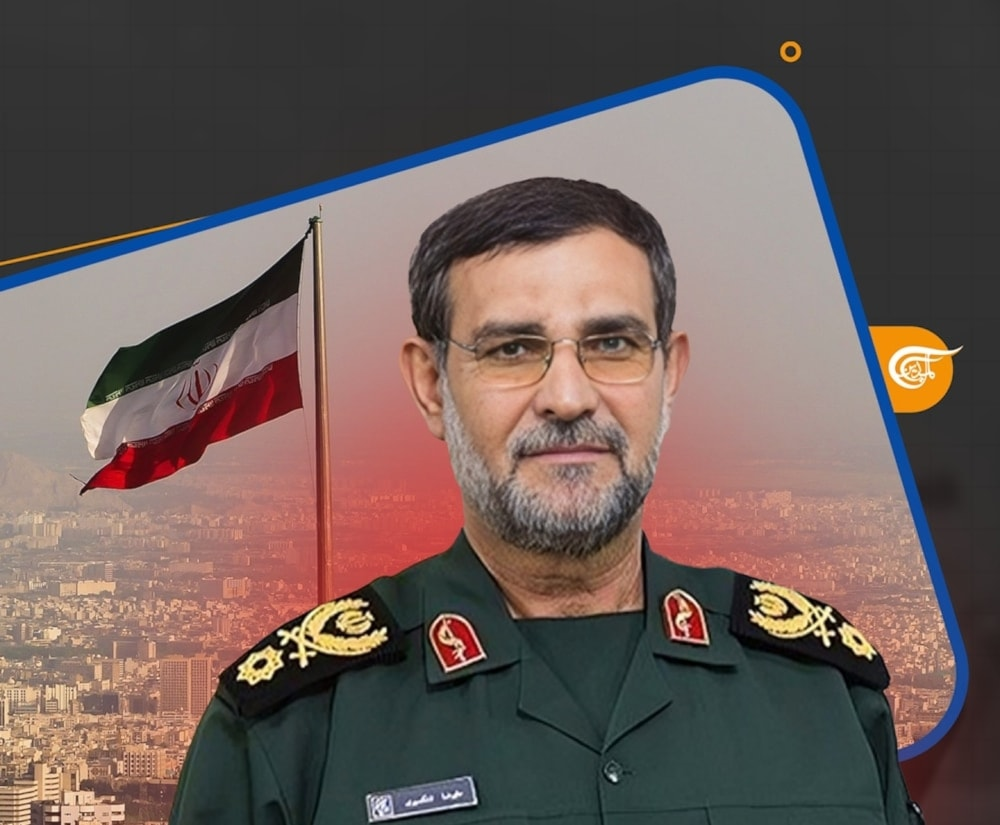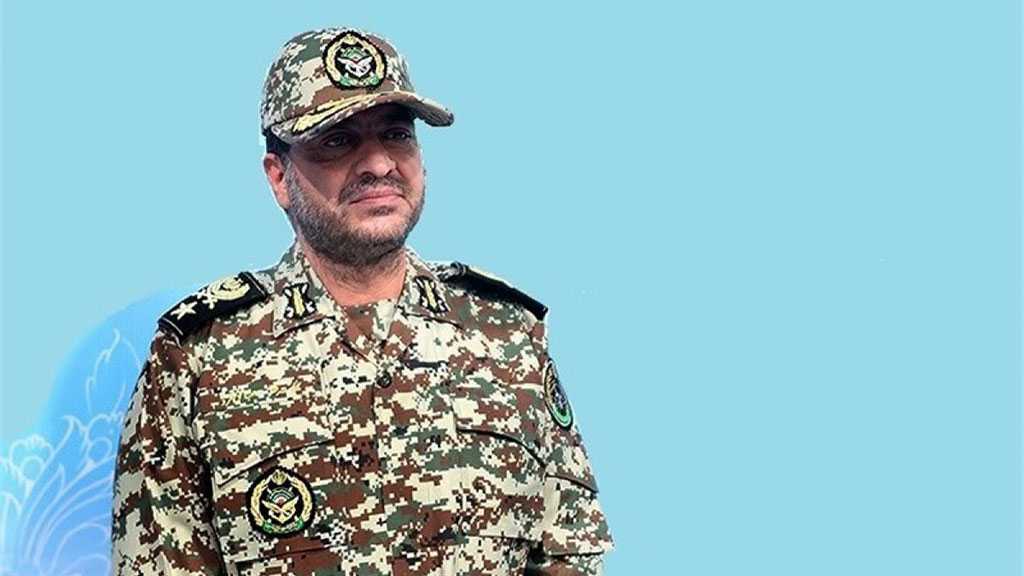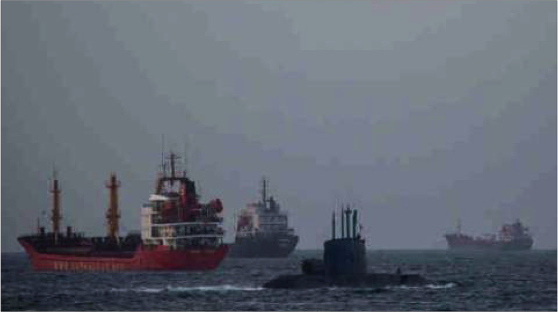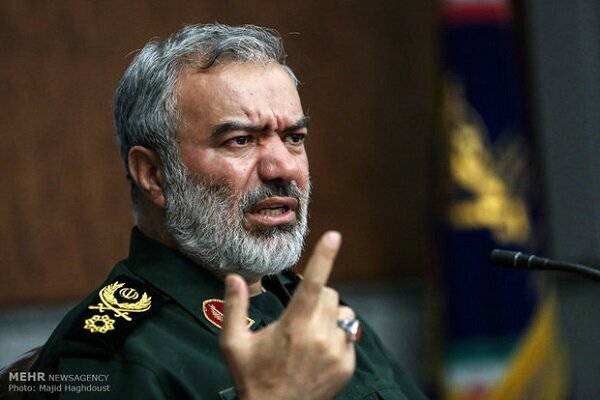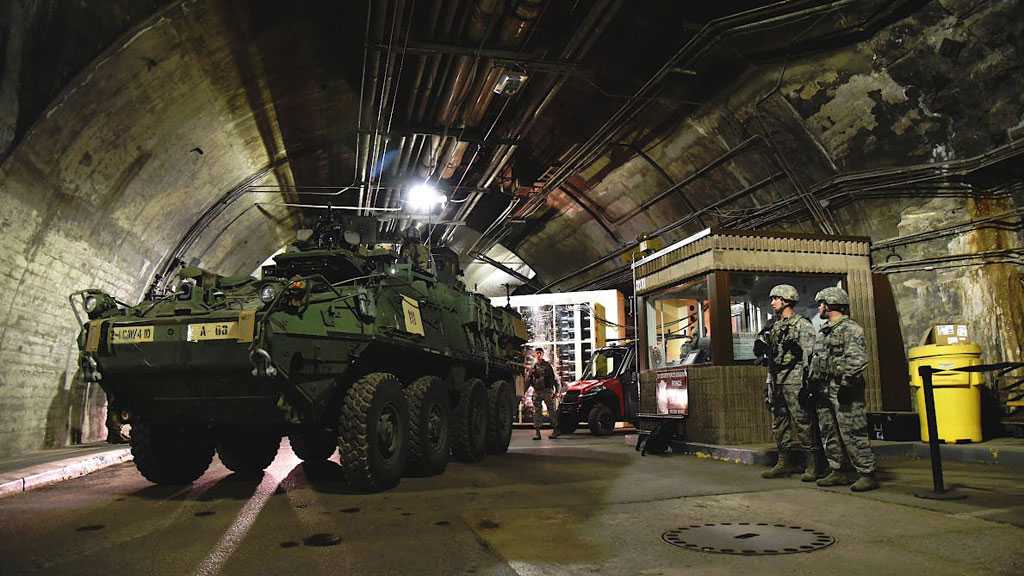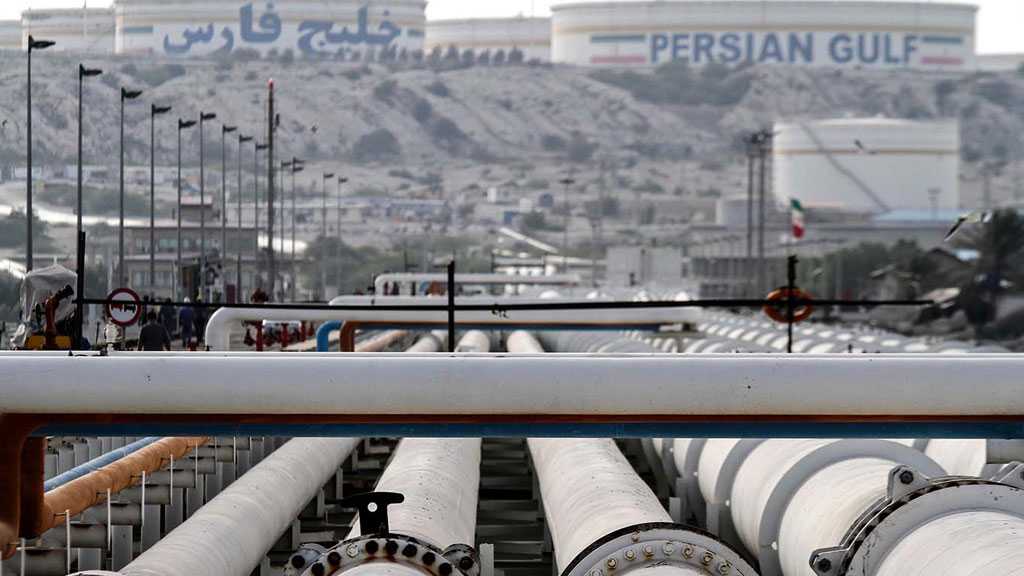In an exclusive interview with Al Mayadeen, the Commander of the IRGC’s Navy, Alireza Tangsiri discusses Iran’s development as a world power, the efforts of the Axis of Resistance to champion and defend Gaza, and the fate of “Israel” and its allies.
Al Mayadeen conducted an interview, which was broadcast on Tuesday, with the commander of the IRGC’s Navy, Admiral Alireza Tangsiri. You can find the full, translated text of the Admiral’s answers below:
I welcome you here, as well as our dear viewers, and welcome to the city of Bandar Abbas and the Strait of Hormuz.
Following the Islamic Revolution’s victory, Washington imposed a complete embargo on Iran, which did not own any material capabilities at the time. Most of our equipment and arsenal were US-made. Later, they would embroil us in an inadequate war against Saddam’s regime, in addition to an abundance of internal conflicts. However, with the grace of God, we managed to persevere and move forward after eight years of war, which prepared us for the upcoming confrontations.
Despite the embargo, sanctions, and economic predicaments Iran was faced with, it was able to advance in multiple military fields, build up its combat strength, manpower, special military training, and manufacture its own equipment.”
“Right now, we are at a level that allows us to export weapons, including rockets, warships, and radars, to naval forces, defense ministries, and armed forces, and we take pride in this capability, which makes rocket and ship manufacturing possible amid the embargo. We also take pride in the size, speed, assimilation, and resistive characteristics of our home-produced ships, which expedites their abilities throughout maritime battles.”
“Today, after over 40 years, we have emerged as a world power, and are the primary decision-makers in West Asia, whether it’s derived from the quality of our manufactured equipment or the preparedness of our armed forces. Today, we are proud to say that Iran is at the forefront in regional power, and produces all it needs to defend its sovereignty,” he said.
On ‘Israel’s’ crushing defeat in Gaza
Speaking on the genocide in Gaza, Tangsiri described “Israel’s” extensive war as “heinous crimes against the oppressed yet brave and resilient Gaza”.
He revisited the Israeli war objectives from the war and affirmed that the occupation did not manage to achieve a single one.
In detail, the Rear Admiral said:
“They claim three determinants for their success in Gaza:
1. Defeating Hamas, but Hamas is stronger than ever, and sustained fewer losses.
2. The people’s desperation and hopelessness; but look at the highly spirited people in Gaza, who have lost their homes and their loved ones but remained resilient and faithful. The Zionists failed to break Gaza’s defiant and steadfast spirit.
3. The swift elimination of Gaza; but the entire world opposes the Zionists today. The “army” that claimed to be the strongest in West Asia, and third strongest in the world, being supported by the US military with aid and developed weapons used in modern wars, employed to kill Gazan children, has failed to achieve victory, whether militarily, politically, or socially.”
When asked about how such an entity could be fought, Tangsiri stressed the importance of Muslim unity.
“The only way to fight the Zionists is through the formation of an Islamic power and a coalition of Islamic armies. To quote Imam Khomeini, may his soul rest in peace, If every Muslim poured a bucket of water on Israel, it would be washed away. Unfortunately, this isn’t the case. Here, I speak to all Muslim nations that think they would attain greater glory by counting on the Zionists’ friendship. The solution to removing the corruptive and criminal parasite is the unification of all Muslim nations and their armies. If we were united, we could bring an end to it. But this is not what is happening. The Zionists are not only treating Muslims this monstrously but have also shown our Christian brothers and sisters no mercy.
They destroyed churches and massacred Christians in Lebanon. The Zionists are not merciful towards anyone, not even their own supporters.
Unfortunately, the Zionists are striking Muslims with warplanes loaded with fuel supplied by Muslim nations. This is a disgrace, and the solution remains in unity against Zionism to ultimately remove it from existence.”
Iran advocates security in region
Tangsiri also detailed the West’s interests in the region, specifically the United States, and emphasized that Iran has always sought peace and security in the spirit of good neighborliness. However, he did not shy away from condemning the actions Iran’s neighboring countries have undertaken, particularly inviting Zionists into the region.
During talks with neighboring countries regarding the Strait of Hormuz, our message has always been that of peace and friendliness. Iran suffered under the oppression of a tyrant, so it revolted and offered martyrs in the quest for victory, but since then, we have been faced with the enmity of those same countries, as well as the United States and more. The US Army has now come to the Strait of Hormuz and the Persian Gulf, but they do not belong in our waters. We previously told our neighbors that the Persian Gulf and Oman’s Sea are national concerns of both them and Iran and that Iran’s security is theirs. We told them the West does not want this region to be stable or secure. The West considers these countries as a “milk cow”, but when the milk runs out, as in oil and gas resources in the region, it would slaughter us.
“Therefore, we have always advocated for the security of the region, and have assured that we can host joint military exercises in the Strait, in collaboration with our brothers from the Persian Gulf’s neighboring countries. We can maintain the region’s peace and security. Our oil and gas terminals are close to those of the neighboring countries. If we really wanted to, we could close these waterways down.
But we do not do this, because as long as we use this waterway and strait, then our neighbors would also have to, and should. But they have to recognize that we will not accept the presence of Zionist supporters in their governments because this is considered a security threat to Iran. We hope they do not make such errors, and reconsider their choices. Should the enemy come and restrain us, and act provocatively in an attempt to incite change in the region, then that is a different issue, to which a different decision would be made, at a later time.
Zionists in countries neighboring Iran
He revealed that Iran is now the main proponent for security of the region and that of the Hormuz Strait, and the constant traffic of more than 85 tankers carrying oil and gas cargo that safely pass through the strait every day.
However, he revealed that the arrival of the Zionists to the region, and their settlement within countries neighboring Iran, does not speak to peace or good neighborliness.
“Iran has relations with Arab countries, and the seven nations of Oman, the UAE, Qatar, Bahrain, Saudi Arabia, Kuwait, and Iraq, but bringing Zionists to our region… We know full well that they do not come for economic purposes or to establish bilateral relations between those countries and the child-killing criminals the world has begun rejecting.”
“What does it mean for a country to take pride in welcoming Zionists to the region?”, he asked.
Related News
- Elon Musk says West attempts to influence X, not Russia
- US Sen. Warren says ‘Israel’ could be found guilty of genocide in ICJ
“What are we to understand from such a gesture to us, to a country whose sea spans the entire length of the Persian Gulf, to a country that has beaches in the sea of Oman, to a country with such glory and greatness? Should we not consider this a threat? Is bringing Zionists to a neighboring country not a threat? They should acknowledge that if harm comes in our country’s way, then the place they came from will cease to exist. If they [neighboring countries] were indeed looking for security, then they would know that there is no room for Zionists in the region.
“I assure you, once again, that we would not attack a Muslim country unless it attacked us… Before the Islamic Revolution’s triumph, Iran had a Ministry of War. Today, we have a Ministry of Defense instead, which signifies that we would not attack any country if we were not attacked or conspired against. Those who choose to conspire and attack us though, will receive a hard blow, just like Saddam and his movement did.
“Therefore, we do not make threats and do not accept threats. Sometimes, a threat is merely speech. The Zionists’ presence in neighboring countries, which we fully acknowledge is not for economic purposes, but rather military and security ones, is a threat that should not materialize. This is a consideration we should always keep in mind.
US forces present in our neighbors’ waters
On the role of the US in the region, Tangsiri affirmed that it is but a plot to incite rifts and destabilize the region and its peace.
The US forces, he stated, are not present in Iran’s waters or territory. However, they are unfortunately present in Iran’s neighbors’ waters, not international ones.
“The United States should realize that the Persian Gulf is not an international sea, but Iran’s and its neighboring countries’. The US does not sail in international waters strait passing through our islands. We are constantly monitoring them, their movements, actions, and behavior. Our naval mission, under the Islamic Revolutionary Guard Corps, is to defend our facilities in the Persian Gulf. We believe that if they enter the region, with their nuclear equipment, then the waters would not be viable for use for years after. We would be the ones affected by their presence.
But it is of their nature to create enemies, why? First, for weapons. And for an excuse to sell weapons. If there was no enemy to fight, then the region would not need weapons. Second, to ensure their presence in the region… If they did not claim an enemy was present in the region, then they would not need to remain in it. If they did, then it would be unjustifiable.
“Therefore, the constant sales of arms and weapons and their illegal presence in the region necessitates their claim of Iran being an enemy to its neighboring countries. If one of these countries gets attacked tomorrow, they will set fire to this land, leave it, and leave us affected. Which is why we should all remain careful and wary.”
The Resistance’s Mission
When asked about the Axis of Resistance, its emergence, and its role in the region, the IRGC commander stated that the Resistance’s mission has always been to champion Palestine and its liberation against “Israel” and its allies.
“The Axis of Resistance has always responded to threats in defense of the Palestinian people, because their lands are occupied and because Gaza’s resilient people are oppressed. We had never seen a people as resistant as that of Gaza. Countries backing the Zionists should be ashamed of themselves. The US supplied the Zionists with special bombs, which were dropped on women and children in Gaza. France, Britain, and others rushed to back the criminal, dirty, malicious, and child-killing Netanyahu… I do not know, are they really human? Do they call themselves human? A little child in fear, and shaking like that… a torn up child and a mother holding her children… I saw a father holding his martyred children in his hands… These countries are only helping this criminal. I believe the blood of over 14,000 children and women and all those innocents will seek retribution for their sins and will be the reason for “Israel’s” demise and end.
Their message was clear: Defend the occupation. And they announced the reason for their presence in the region in the Mediterranean and the Red Sea. If you recall, in the early days of the war, a US aircraft carrier traveled through the Strait of Gibraltar and remained stationed in the Mediterranean.
What is the message it is carrying? That it intends to defend the Israeli occupation, which marks an eternal disgrace for them [the US]. The United States, in all its might – as it claims – and capabilities, and Britain and its capabilities, as well as France… They all came to murder innocent people. How could they raise their heads high as a moral army? Every army has pride, but it comes from respecting and adhering to the laws of war. But this is not a war. This is a people, in a very small land, surrounded and defenseless. But God is with them, and through Him, they will prevail.
At the start of this interview, I noted that the Zionists are so far defeated, and have not achieved any of their war objectives. Did they retrieve their captives? No. Did they destroy Hamas? No. Were they able to achieve their goal of victory? No, they did not emerge victorious, defeat Hamas, or release the hostages. So, they lost. It has been six months. And we cannot forget that six Arab Muslim nations did not achieve victory in the six-day war,” the leader reiterated.
Yemen, Hezbollah role in war
During the interview, Tangsiri was also asked about Yemen and Hezbollah’s role in the war against “Israel”.
To that, he stated that Hezbollah today is heroic, it is far stronger than it was at the beginning of the war, but until this moment, Hezbollah has not responded to the Zionist enemy, and were it to respond, it would have been an onslaught. Sayyed Hassan Nasrallah had previously announced that Hezbollah’s response would be fierce. Yemen today is much more solid than before, and Iraq and Iraqi Hezbollah are far stronger than before… The Resistance movements that surround the Zionist entity are the more powerful…
He called for trust in the Resistance, saying, “Do not worry about the Resistance; it is today capable of doing everything, and it is far stronger than it was in the earlier days of the war.”
Attack on Iranian consulate
Commenting on the Israeli attack on the Iranian consulate in Syria, he denounced the deliberate airstrike and highlighted the West’s hypocrisy in that regard.
According to Tangsiri, this crime did not happen in any other war. Embassies are meant to be safe places and are considered the territory of their respective countries. In that embassy, there were not only military advisors, but also women, children, and men.
“This attack is a crime. First of all, if we had done this, which we would never have, they would have strongly condemned us for committing such a crime. Look at the world, at the Europeans who watch these crimes and support the most corrupt people, and at the US which plays a very democratic and liberating role… We expected the United Nations to confront this crime more firmly, but they paved the way for us to do away with this ugliness.”
He also reaffirmed that Iran intends to respond to “Israel” for its crime.
“As our dear leader said, it will be responded to, but we do not act impulsively or hastily. We are not the kind of people who turn the other cheek after being hit. At the appropriate time, the relevant officials will deliver a strong blow, God willing. At the head of our armed forces is a scholar who knows God, is patient, wise, and rational and logically governs the Iranian armed forces. We act and respond when we see fit. But we will definitely respond, and as the leader said, we will not leave the matter unanswered.
“We are a force ready for battle. We are military men. We are ready for any mission they order us to carry out. Do you expect me to say what we will do? That is not correct. We are 100% ready for any order that may be issued. Today, the naval forces of the Islamic Revolution Guards Corps and our heroic army are ready to pluck out the eye of anyone who wants to harm our country and will carry out the orders that may be issued at the appropriate time.”
Western powers have brought in their ships to support the occupation, but the brave Yemenis withstood against them. As our leader said, if Yemen was not under siege, we would have certainly aided it. Yemen today produces its own artillery, missiles, and boats, and is standing strong against the enemies, against the US and Britain, in support of the oppressed people of Palestine and Gaza.
Glorious Yemen
Discussing Yemen’s development as a Resistance power as well, Tangsiri said that after eight years of an imposed and harsh war against the country, Ansar Allah, and the Yemeni Army, it has now reached a level where it can confront great powers such as the United States.
He said that Ansar Allah is manufacturing missiles and unmanned aerial vehicles (UAVs) and has established a naval force, despite the embargo and sanctions imposed on the country.
Sayyed Abdul-Malik al-Houthi affirmed that they could target the West’s ships, even if they were in Southern Africa. Today, Tangsiri said, Ansar Allah is targeting ships 600, 700, and even 1,000 kilometers away. Day after day, Ansar Allah keeps developing its capabilities. There are brave men taking control of the force and defending their country.
He stressed Yemen’s independence from Iran despite being allied and part of the Axis of Resistance, against claims that Resistance factions in the region serve as Iran’s proxies.
“Yemen is an independent country, and the Resistance is an independent force that was born to crush oppression. Yemen and its Resistance do not wait for our orders, but we are indeed concerned with the Resistance.
“We love the Palestinians, and we support anyone who takes a stance against oppression and struggles in the fight for the cause. We saw injustice in Bosnia and Herzegovina, and although we did not have common borders with them, and their population included both Muslims and non-Muslims, we helped them and offered them moral support, and never fell short in the help we could offer. We stand with the oppressed. We love and appreciate the men of the Resistance in Yemen, and take pride in them. The Islamic world must take pride in them. They do not need a force that leads them, because they have a leader. Just like Hezbollah has a leader, and Yemen and Iraq have leaders, and they act based on their interests. They have enough wisdom to know when and how to act.”
The Final Message
Before concluding the interview, the IRGC admiral called on Muslim nations, specifically those neighboring Iran, and said ‘Life is fleeting, and if we do not defend those that are oppressed, we will be asked about it on Judgment Day. I am addressing Muslim leaders who own the means of governing. Take the opportunity, because while Christians and followers of other religions protest in solidarity with Gaza, it is a disgrace that Arab countries do not hold such marches and protests.’
I also wish to address the leaders that are fueling the Zionist enemy’s jetplanes… [How can] they take our oil and turn it into fuel for a bomb they drop over the heads of Muslims who say ‘There is no god but God, God is great, and God is sufficient for us’? Are they not the people that are dropping bombs on Gaza’s people? The war will end, and God willing, The people of Gaza will emerge victorious. But what have we offered during this time?
“We ask God to raise the martyrs of Gaza and the Resistance, whether in our dear Lebanon, dear Iraq, or dear Yemen, to where the prophet of God and his holy Imams rest.”
In his last address to the Al Mayadeen crew conducting the interview, he expressed his thanks, saying “I profoundly thank you, particularly for coming here twice. Forgive us for the warm weather, and perhaps the circumstances were more difficult for you, but we fully know that your cameras are important, and powerful, just like Al Mayadeen. It is the voice of the oppressed, and you represent their voices. God willing, He will note what you have done for the oppressed, and you will hold your heads high before the Resistance’s martyrs and the oppressed people of Gaza.”
Related Videps
Related Stories
- Israeli attack on Iran consulate greenlit by US, FM says
- Iran vows to punish ‘Israel’ for attack on Iranian consulate in Syria
- ‘Israel’ to receive slap in face for consulate attack: Sayyed Khamenei
- Axis of Resistance Leaders speak ahead of Al-Quds Day
- Saudi Arabia bleeding funds for Vision 2030: Broken economic model
- The Art of War: Different Thinking Systems
- Iran response to consulate attack definitely coming: Sayyed Nasrallah
- Resistance in Palestine: What would Che Guevara do?
- Austin reaffirms unwavering support for ‘Israel’ amid rising tensions
- Iranian Pres. urges Muslim countries cooperation to stop Gaza genocide
- Elon Musk says West attempts to influence X, not Russia
- IOF continue to brutally attack the Gaza Strip
- Day 186: 33,360 killed, 75,993 injured in Gaza
- Time is on Hamas’s side, Netanyahu misses opportunity, newspaper says
- French FM suggests sanctions on ‘Israel’ to allow aid into Gaza
- US says goal is to stop Russia from developing new energy projects
- Russia and China to start dialogue on creation of Eurasian security
War on Gaza
Filed under: Bahrain, IRAQ, Lebanon, Lebanon Islamic Resistance - Hezbollah, Oman, Qatar, Saudi Arabia, The Islamic Republic of Iran, United Arab Emirates UAE, United Kingdom UK, USA, Yemen, Yemeni Ansarullah | Tagged: Arab Zionists, Besieged Gaza Strip., Persian Gulf, Sayyed Abdulmalik Al-Houthi, Sea of Oman, Strait of Gibraltar, Strait of Hormuz, The Axis of Resistance, The Commander of the IRGC's Navy Alireza Tangsiri, The Islamic Revolution Guard [IRGC], The Zio-temporary entity, Yemeni Ansarullah | Comments Off on Axis of Resistance’s mission is to defend Palestine: IRGC’s Navy Cmd.




